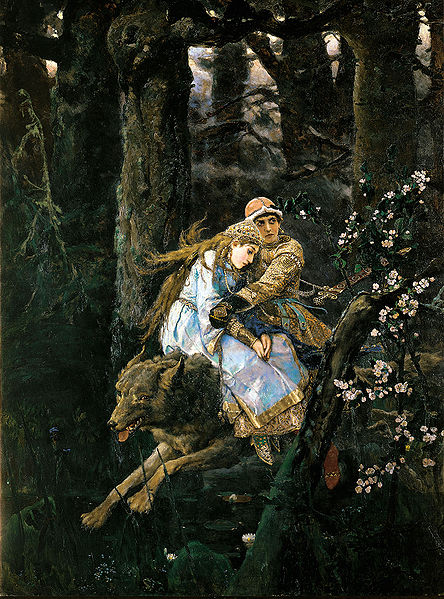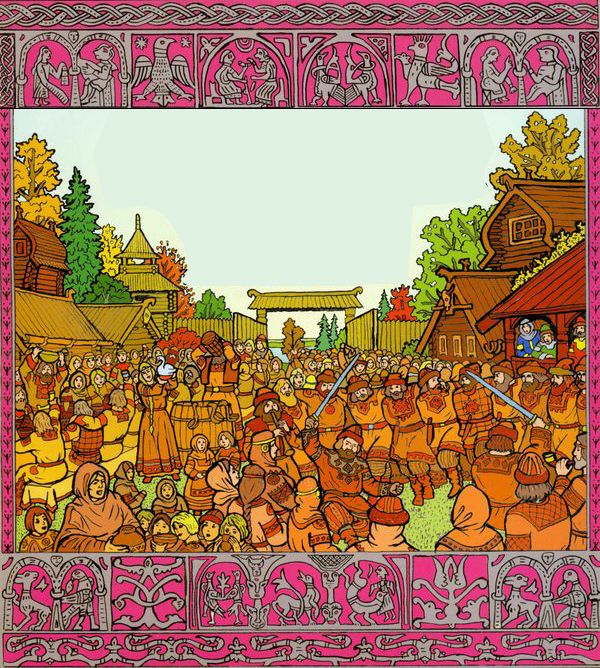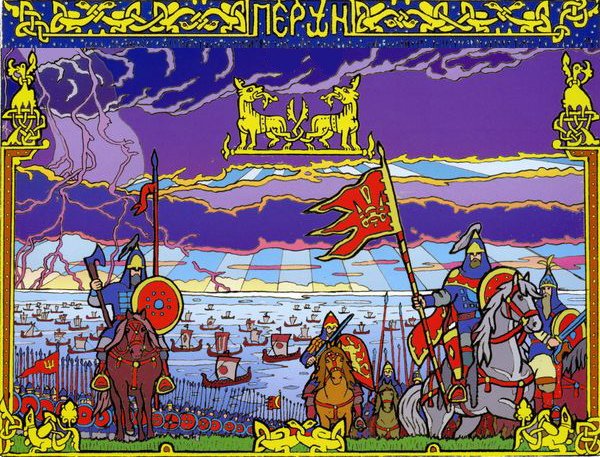
A Labour of Love
Gianni Vacca
Part 1: Issue 13, Summer 2012
Part 2: Issue 14, Autumn 2012
Part 3: Issue 15, Winter 2013
Playing Tunnels & Trolls in Glorantha
Part One: Introduction
Glorantha is a setting that hasn’t been linked to a particular game system for several years now. Although Glorantha started as the default setting for the original editions of RuneQuest by Chaosium (1st and 2nd editions), the 3rd edition of the game was setting-agnostic. Glorantha was only supported by its fans for several years after that, then it became the default setting for Hero Wars and HeroQuest, two games with a completely different ‘engine’. Then in 2006, Mongoose re-booted RuneQuest with a different Gloranthan setting (the Second Age instead of the canonical Third Age) and published an incredible number of background manuals. Although the licence lapsed in 2010-11, these manuals are still easy to find, especially in their pdf version.Since Glorantha isn’t linked to a particular game system any more, why not use one’s favourite game ‘engine’ to adventure in this fantastic world? Personally I’ve chosen Tunnels & Trolls (T&T).
 T&T (1975) is one of the very first role-playing games, and possibly one of only two role-playing games that have been continuously in print without any major rule system overhauls for more than thirty years – the other one being Call of Cthulhu.
T&T (1975) is one of the very first role-playing games, and possibly one of only two role-playing games that have been continuously in print without any major rule system overhauls for more than thirty years – the other one being Call of Cthulhu.
At first sight, T&T shows its age and its game system may be considered as obsolete. However, as always with role-playing games, a game is but what its users use it for. Let me explain to you why I consider T&T as one of the most versatile and modern systems on the market.
T&T only uses the D6. It has a very simple engine, which uses two basic (and unrelated) mechanisms: 1) A generic skill system used for everything except mêlée combat, based on 2D6+skill value against a difficulty level. 2) A dice pool system used for mêlée combat only. With a single roll, you know if you hit, whether you crit, and how much damage you deliver.
Except for mêlée combat, the system is not that different from HeroQuest, especially since the T&T talents are ‘open’ and not to be chosen amongst a set list. Mêlée combat does use a different system, but at least it’s simpler than HeroQuest’s extended contest and its headaches.
T&T player characters are defined by their attributes and their talents [skills], the latter being derived from the former. The distinction, however, is not as clear-cut as, say, in RuneQuest, since attributes are used much like skills, e.g., if your PC wants to jump a chasm you have to roll against your DEX unless you happen to have a Jump talent, in which case you use the Talent. If the PC is carrying a heavy load, the GM may require the player to roll against the average of STR and Jump. A truly versatile system, again not unlike HeroQuest’s augments. T&T player characters also have a level. But unlike the level system of that other fantasy role-playing game, levels in T&T are determined by the values of the skills (and not the other way round!). Levels have a minimal impact on the game system, mostly through bonuses for some skill rolls, and by setting minimum level requirements to access some spells – not unlike RuneQuest, where some spells were restricted to rune-level characters.
T&T player characters also have to choose a character class. Unlike the class system of that other fantasy role-playing game, T&T character classes are mostly archetypes: being a Warrior is not unlike being an initiate of Humakt as per Cults of Prax!
Timinits & Trolls is a homebrew old-school fantasy role-playing system designed for sword-and-sorcery adventures in the Second Age of Glorantha. As implied by its name, Timinits & Trolls is based on the classic Tunnels & Trolls frp game, with good measures from the 1976 ‘Perrin Conventions’ and from the original RuneQuest game.
A copy of the 7th edition of Tunnels & Trolls is necessary to enjoy Timinits & Trolls.
This game does not claim ownership of the Tunnels & Trolls name or copyright. All of these are copyrighted to or trademarked by Ken St. André and/or Flying Buffalo, Inc. This game is not intended as an infringement on any copyright, nor is it an attempt to challenge any trademarks.
Glorantha is the creation of Greg Stafford. Greg Stafford and Issaries, Inc. reserve the right to use any Gloranthan names, places, and concepts, developed in this Gloranthan fan publication, in any future Gloranthan development or publications, without further credit or payment. Glorantha, RuneQuest and HeroQuest are registered trademarks of Issaries, Inc and used with permission.
More information about Timinits and Trolls can be found at 2ndage.blogspot.com
I – HISTORY
 They call it the Imperial Age, but we call it the Forlorn Tide.
They call it the Imperial Age, but we call it the Forlorn Tide.It did start well, though. The Empire was good at the time. Imperial ships took us from the barren lands of our forefathers and brought us to our new home. Imperial settlers helped us clear the woods and drain the marshes. This also drove out the wort-men who lived here before we did.
We grew and we thrived on this new land of ours with rolling hills and open fields. The Imperials lived in their great towns on the shore, we lived in our steads and townlets and kept to ourselves. But the Empire grew wicked and slanderous. Our elders had to bow down to their aldermen; our warriors were taken far away to fight wars which weren’t our wars. Many did not return. Worse of all, however, was the path that the Imperial wizards took. They built their lore halls where they would grow in uncouth spellcraft-lore and dwimmer-lore, and whence fearsome gear-beings stepped out. They brought in bug-men from their home island. This was too much. We got together, swore oaths of help and brotherhood, and set upon the evil that the Empire had become. The struggle was long and harsh but in the end we won.
Life is tough, though. Trade hasn’t borne our newfound freedom well. The great towns on the shore yielded to us, but kept many of their wizards who may still plot against us. Leftovers of their eerie experiments are still there; fearsome fiends dwell in forsaken wrecks. Yet young daredevils set out to delve into those stows. This game is about their undertakings.
TIMELINE
475 ST: The Aldryami exterminate the last of the Lascerdans580 ST: First human settlers (Storm Worshippers), from a very far continent north of the Ocean
Early 7th century: more human settlers (mostly Malki), from many lands of the Empire of the Land and Sea
654 ST: The Empire of the Land and Sea devastates the Elf forest of Vralos
789 ST: The coalition of Malki Cities in Umathela joins the Empire of the Land and Sea
806 ST: Establishment of the Order of Otherworld Exploration
845 ST: Formation of the God Learners’ Collective
901 ST: False Gods Revolt; destruction of the Malki University of Yoranday
901-911 ST: The Pamaltelan Wars:
- Fonritan cities revolt from God Learners.
- The Duchy of Kolar (aka the “Six-Legged Empire") is annihilated by the Agimori. Its few ruins are accursed and shunned.
- A coalition of Umathelan rebels prevents Imperial ships from landing.
922 ST: Last Imperial possessions in Pamaltela are lost (i.e. find independence from the Empire)
940 ST: Jrustela sunk
942 ST: Closing scoured Fonrit coasts
943 ST: Pillars of Water rise in Kareeshtu
944 ST: Pillars of Water splash onto land, Fleet of the Dead sails
950 ST: A Jrusteli scholar publishes a book proving that the Elves of Enkloso are extinct
 954 ST: just before the Closing— a fleet of Waertagi ships arrives from the sea, smashes the rest of the hated universities into gravel and pulp
954 ST: just before the Closing— a fleet of Waertagi ships arrives from the sea, smashes the rest of the hated universities into gravel and pulp
955 ST: Worst of Closing over in Fonrit
955 ST: The Closing reaches Umathela and Teleos
956 ST: Closing reaches Marthino Sea
975 ST: A plague of insects ends dynasty of Errinoru (Jungle Elves)
1020 ST: Legions of Elves march from secret lairs, defeat the self-styled Lord of the World’s Knowledge, ruler of Vralos and Enkloso
Part 1: Issue 13, Summer 2012
Part 2: Issue 14, Autumn 2012
Part 3: Issue 15, Winter 2013





